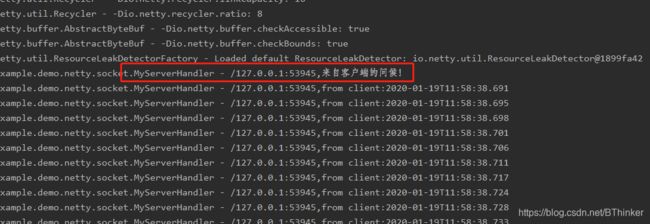Netty实现简单的Socket通讯
Netty实现简单的Socket通讯
Netty简介
Netty是由JBOSS提供的一个java开源框架。Netty提供异步的、事件驱动的网络应用程序框架和工具,用以快速开发高性能、高可靠性的网络服务器和客户端程序。也就是说,Netty 是一个基于NIO的客户、服务器端编程框架,使用Netty 可以确保你快速和简单的开发出一个网络应用,例如实现了某种协议的客户,服务端应用。Netty相当简化和流线化了网络应用的编程开发过程,例如,TCP和UDP的socket服务开发。
Netty 是一个吸收了多种协议的实现经验,这些协议包括FTP,SMTP,HTTP,各种二进制,文本协议,并经过相当精心设计的项目,最终,Netty 成功的找到了一种方式,在保证易于开发的同时还保证了其应用的性能,稳定性和伸缩性。
本文目的
使用Netty实现一个Socket通讯,包括客户端和服务端,通过服务端进行监听,客户端发送信息,服务端可进行接收,并进行返回数据,完成一个完整的通讯。
依赖引入:
implementation 'io.netty:netty-all:4.1.43.Final'
io.netty
netty-all
4.1.43.Final
服务端编码
a.MyService.java
import io.netty.bootstrap.ServerBootstrap;
import io.netty.channel.ChannelFuture;
import io.netty.channel.EventLoopGroup;
import io.netty.channel.nio.NioEventLoopGroup;
import io.netty.channel.socket.nio.NioServerSocketChannel;
public class MyServer {
public static void main(String[] args) {
//循环组接收连接,不进行处理,转交给下面的线程组
EventLoopGroup bossGroup = new NioEventLoopGroup();
//循环组处理连接,获取参数,进行工作处理
EventLoopGroup workerGroup = new NioEventLoopGroup();
try {
//服务端进行启动类
ServerBootstrap serverBootstrap = new ServerBootstrap();
//使用NIO模式,初始化器等等
serverBootstrap.group(bossGroup, workerGroup).channel(NioServerSocketChannel.class).childHandler(new MyServerInitializer());
//绑定端口
ChannelFuture channelFuture = serverBootstrap.bind(9008).sync();
channelFuture.channel().closeFuture().sync();
} catch (InterruptedException e) {
e.printStackTrace();
} finally {
bossGroup.shutdownGracefully();
workerGroup.shutdownGracefully();
}
}
}b.MyServerInitializer.java
import io.netty.channel.ChannelInitializer;
import io.netty.channel.ChannelPipeline;
import io.netty.channel.socket.SocketChannel;
import io.netty.handler.codec.LengthFieldBasedFrameDecoder;
import io.netty.handler.codec.LengthFieldPrepender;
import io.netty.handler.codec.string.StringDecoder;
import io.netty.handler.codec.string.StringEncoder;
import io.netty.util.CharsetUtil;
public class MyServerInitializer extends ChannelInitializer {
//连接注册,创建成功,会被调用
@Override
protected void initChannel(SocketChannel ch) throws Exception {
ChannelPipeline pipeline = ch.pipeline();
pipeline.addLast(new LengthFieldBasedFrameDecoder(Integer.MAX_VALUE, 0, 4, 0, 4));
pipeline.addLast(new LengthFieldPrepender(4));
pipeline.addLast(new StringEncoder(CharsetUtil.UTF_8));
pipeline.addLast(new StringDecoder(CharsetUtil.UTF_8));
pipeline.addLast(new MyServerHandler());
}
} c.MyServerHandler.java
import io.netty.channel.ChannelHandlerContext;
import io.netty.channel.SimpleChannelInboundHandler;
import org.apache.commons.logging.Log;
import org.apache.commons.logging.LogFactory;
import java.util.UUID;
public class MyServerHandler extends SimpleChannelInboundHandler {
private Log LOGGER = LogFactory.getLog(MyServerHandler.class);
@Override
protected void channelRead0(ChannelHandlerContext ctx, String msg) throws Exception {
LOGGER.info(ctx.channel().remoteAddress() + "," + msg);
ctx.channel().writeAndFlush("from service:" + UUID.randomUUID());
}
@Override
public void exceptionCaught(ChannelHandlerContext ctx, Throwable cause) throws Exception {
cause.getCause();
ctx.channel().close();
}
} 客户端编码
a.MyClient
import io.netty.bootstrap.Bootstrap;
import io.netty.channel.ChannelFuture;
import io.netty.channel.EventLoopGroup;
import io.netty.channel.nio.NioEventLoopGroup;
import io.netty.channel.socket.nio.NioSocketChannel;
public class MyClient {
public static void main(String[] args) {
EventLoopGroup eventLoopGroup = new NioEventLoopGroup();
try {
Bootstrap bootstrap = new Bootstrap();
bootstrap.group(eventLoopGroup).channel(NioSocketChannel.class).handler(new MyClientInitializer());
//绑定服务器
ChannelFuture channelFuture = bootstrap.connect("127.0.0.1", 9008).sync();
channelFuture.channel().closeFuture().sync();
} catch (Exception e) {
e.printStackTrace();
eventLoopGroup.shutdownGracefully();
}
}
}
b.MyClientInitializer.java
import io.netty.channel.ChannelInitializer;
import io.netty.channel.ChannelPipeline;
import io.netty.channel.socket.SocketChannel;
import io.netty.handler.codec.LengthFieldBasedFrameDecoder;
import io.netty.handler.codec.LengthFieldPrepender;
import io.netty.handler.codec.string.StringDecoder;
import io.netty.handler.codec.string.StringEncoder;
import io.netty.util.CharsetUtil;
public class MyClientInitializer extends ChannelInitializer {
//连接注册,创建成功,会被调用
@Override
protected void initChannel(SocketChannel ch) throws Exception {
System.out.println("initChannel");
ChannelPipeline pipeline = ch.pipeline();
pipeline.addLast(new LengthFieldBasedFrameDecoder(Integer.MAX_VALUE, 0, 4, 0, 4));
pipeline.addLast(new LengthFieldPrepender(4));
//编解码
pipeline.addLast(new StringEncoder(CharsetUtil.UTF_8));
pipeline.addLast(new StringDecoder(CharsetUtil.UTF_8));
pipeline.addLast(new MyClientHandler());
}
} c.MyClientHandler.java
import io.netty.channel.ChannelHandlerContext;
import io.netty.channel.SimpleChannelInboundHandler;
import org.apache.commons.logging.Log;
import org.apache.commons.logging.LogFactory;
import java.time.LocalDateTime;
public class MyClientHandler extends SimpleChannelInboundHandler {
private Log LOGGER = LogFactory.getLog(MyClientHandler.class);
@Override
protected void channelRead0(ChannelHandlerContext ctx, String msg) throws Exception {
LOGGER.info(ctx.channel().remoteAddress());
LOGGER.info("client output:" + msg);
ctx.writeAndFlush("from client:" + LocalDateTime.now());
}
@Override
public void channelActive(ChannelHandlerContext ctx) throws Exception {
ctx.channel().writeAndFlush("来自客户端的问候!");
}
@Override
public void exceptionCaught(ChannelHandlerContext ctx, Throwable cause) throws Exception {
cause.printStackTrace();
ctx.channel().close();
}
}
启动测试

